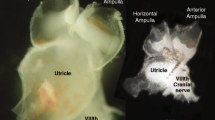Summary
The presence of striated organelles in the vestibular receptor of human fetuses of 10 to 22 weeks gestation was investigated. They were very frequent under the cuticular plate of the sensory cells, especially in type-I hair cells. Cross-sections of striated organelles showed that there were twice as many filaments in the dark bands as in the light bands. These filaments were often arranged in broken lines. Striated organelles were frequently associated with microtutules, mitochondria, and endoplasmic reticulum, and were fused with the plasma membrane forming an incomplete ring in the cytoplasm of the cells. We discuss the possibility that in adults, these striated organelles participate in an active mechanism that regulates the transduction of stimuli by means of a feedback control of the apical part of the calyx.
Similar content being viewed by others
References
Arima T, Uemura T, Yamamoto T (1985) Three-dimensional features of the striated organelle in the vestibular hair cell. Hearing Res 18:15–18
Brownell WE, Bader CR, Bertrand D, de Ribaupierre Y (1985) Evoked mechanical responses of isolated cochlear outer hair cells. Science 227:194–196
Favre D, Bagger-Sjöbäck D, Mbiene P, Sans A (1986) Freezefracture study of the vestibular hair cell surface during development. Anat Embryol 175:69–76
Flock Å (1983) Hair cells, receptors with a motor capacity? In: R. Klinke and R. Hartman (eds). Hearing Physiological basis and psychophysics. Springer, Berlin Heidelberg New York, pp 1–6
Friedmann I, Cawthorne T, McLay K, Bird ES (1963) Electron microscopic observations on the human membranous labyrinth with particular reference to Ménière's disease. J Ultrastruct Res 9:123–138
Friedmann I, Dadswell J.V., Bird ES (1966) Electron microscope studies of the neuroepithelium of the inner ear in guinea pigs treated with neomycin. J Pathol Bact 92:415–422
Friedmann I, Cawthorne T, Bird ES (1965) The laminated cytoplasmic inclusions in the sensory epithelium of the human macula. Further electron microscopic observations in Ménière's disease. J Ultrastruct Res 12:92–103
Graig SW, Pardo JV (1979) Alpha-actinin localization in the junctional complex of intestinal epithelial cells. J Cell Biol 80:203–210
Hirokawa N, Tilney LG (1982) Interactions between actin filaments and between actin filaments and membranes in quickfrozen and deeply etched hair cells of the chick ear. J Cell Biol 95:249–21
Hirokawa N, Cheney R, Willard M (1983) Location of a protein of the fodrin-spectrin-TWH260/240 family in the mouse intestinal brush border. Cell 32:953–995
Hoshino T (1975) An electron microscopic study of the otolithic maculae of the lamprey (Entosphenus japonicus). Acta Otolaryngol (Stockh) 80:43–53
Jahnke V (1969) Ultrastructure of the vestibular sensory areas in experimental lathyrism. Acta Otolaryngol (Stockh) 68:336–349
Jorgensen JM (1982) Microtubules and laminated structures in inner ear hair cells. Acta Otolaryngol (Stockh) 94:241–248
Karlsson U, Andersson-Cedergrenn E (1968) Small leptomeric organelles in intrafusal muscle fibers of the frog as revealed by electron microscopy. J Ultrastruct Res 23:417–426
Lowenstein O, Osborne MP (1964) Ultrastructure of the sensory hair-cells in the labyrinth of the ammocoete larva of the lamprey, Lampetra fluviatilis. Nature 204:197–198
Rosenhall U, Engström B (1975) Surface structures of the human vestibular sensory regions. Acta Otolaryngol (Stockh) Suppl 319:1–18
Ross M (1982) Striated organelles in hair cells of rat inner ear maculas: description and indication for transduction. The Physiologist 25: Suppl S113-S114
Ross M, Bourne C (1983) Interrelated striated elements in vestibular hair cells of the rat. Science 220:622–623
Salisbury JL, Floyd GL (1978) Calcium-induced contraction of the rhizoplast of a quadriflagellate green alga. Science 202:975–977
Sans A, Dechesne C (1987) Afferent nerve ending development and synaptogenesis in the vestibular epithelium of human fetuses. Hearing Res 28:65–72
Sans A, Etchecopar B, Brehier A, Thomasset M (1986) Immunocytochemical detection of “vitamin D-dependent” calcium-binding protein (CaPB-28k) in vestibular sensory hair cells and vestibular protein neurones of the cat. Brain Res 364:190–194
Sans A, Brehier A, Moniot B, Thomasset M (1987) Immuno-electronmicroscopic localization of “vitamin D-dependent” calcium-binding protein (CaBP-28K) in the vestibular hair cells of the cat. Brain Res 435:293–304
Sans A, Atger P, Cavadore C, Cavadore JC (1989) Immunocytochemical localization of myosin, tropomyosin and actin in vestibular hair cells of human fetuses and cats. Hearing Res (in press)
Scarfone E, Demêmes D, Jahn R, de Camilli P, Sans A (1988) Secretory function of the vestibular nerve chalice suggested by presence of vesicles, synapsin I and synaptophysin. J Neurosci 8:4640–4645
Scarfone E, Demêmes D, Perrin D, Aunis D, Sans A (1988) α-Fodrin (brain spectrin) immunocytochemical localization in vestibular hair cells. Neurosci Lett 93:13–18
Slepecky N, Hamernik RP, Henderson D (1980) A re-examination of a hair cell organelle in the cuticular plate region and its possible relation to active processes in the cochlea. Hearing Res 2:413–421
Slepecky N, Hamernik RP, Henderson D (1981) The consistent occurrence of a striated organelle (Friedmann body) in the inner hair cells of the normal chinchilla. Acta Otolaryngol (Stockh) 91:189–198
Slepecky N, Chamberlain SC (1982) Distribution and polarity of actin in the sensory hair cells of the chinchilla cochlea. Cell Tissue Res 224:15–24
Zenner HP (1986) Motile responses in outer hair cells. Hearing Res 22:3–90
Author information
Authors and Affiliations
Rights and permissions
About this article
Cite this article
Sans, A. Ultrastructural study of striated organelles in vestibular sensory cells of human fetuses. Anat Embryol 179, 457–463 (1989). https://doi.org/10.1007/BF00319588
Accepted:
Issue Date:
DOI: https://doi.org/10.1007/BF00319588




